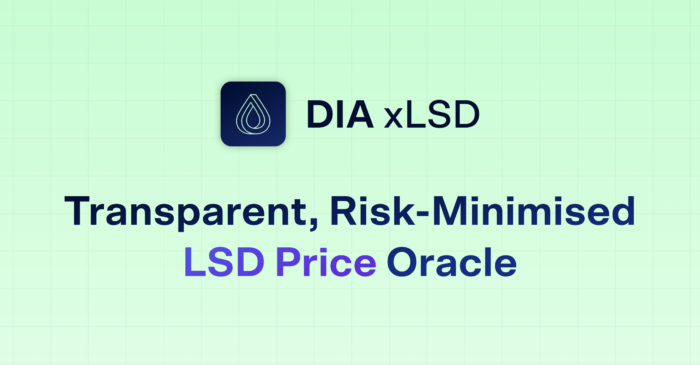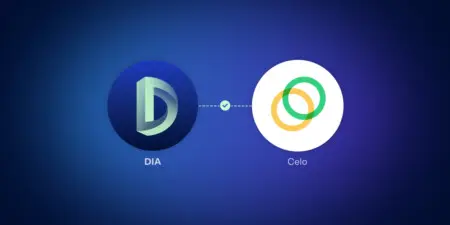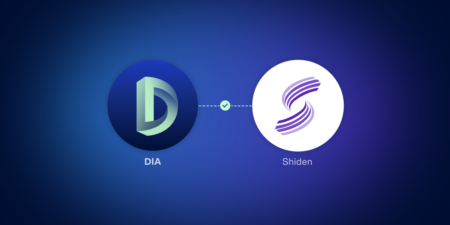DIA xLSD: Price Oracles for Liquid Staked Derivatives
Introducing xLSD: a new oracle product for DeFi protocols to access $5bn+ of idle TVL from Liquid Staked Derivatives — minimizing risk through transparency and collateral-proofing.

TLDR
- Currently, LSDs are listed on few exchanges with low trading volumes and liquidity may not reflect their fair value and can be manipulated
- DIA introduces xLSD price feeds, calculated through on-chain collateral ratio checks on LSD protocols (e.g. Lido)
- DIA xLSD replaces reliance on low liquidity and low-frequency markets for pricing information, providing more accurate and transparent pricing information for LSDs in DeFi.
- DIA xLSD oracles support DeFi use cases with LSDs (Lending, Borrowing, Money Markets, Options), price oracles are necessary
A Primer on Liquid Staking
Proof-of-Stake Chains and Native Staking
With the launch of PoS blockchains, anyone could participate in securing the network and earning rewards by locking up a chain’s native tokens and becoming a validator. On Ethereum, users can either stake 32 ETH and become a full validator or join a 3rd party staking pool through a CEX, for instance. This forced users to lock up their ETH and forgo opportunities to generate yield or participate in governance. Additionally, PoS networks also suffered from the lack of liquidity in the market due to their native tokens being locked up and idle.
Liquid Staking Removes these Barriers
Liquid staking enables users to get the yield of staking a chain’s assets while retaining liquidity: Liquid staking protocols allow users to stake any amount of an L1’s native token, but instead of just locking them up, they deposit users’ tokens into a network’s deposit contract and mint a derivative token, called a Liquid Staked Derivative (LSD). These LSDs are expected to retain the same value as the underlying staked tokens and can be easily transferred, stored, spent, or traded just like regular tokens.
According to Nansen, 15.87 million ETH ($19.3 billion) has been staked, accounting for 13.2% of all circulating ETH. Lido Finance is still the dominant liquid staking provider, commanding 80% of the market.
Unlocking Billions: LSDs go DeFi
As the popularity of LSDs grows, DeFi protocols have demonstrated increasing demand to support the usage of these derivatives in their dApps including lending and borrowing, money markets, options, futures and more. To enable that, price oracles are required that provide price references of LSDs to smart contracts on-chain.
As most LSDs are currently only listed on a few exchanges and often exhibit low trading volumes and liquidity, oracles that report market prices may not always reflect the fair value of such an asset, and can be easily susceptible to price manipulations, causing vulnerabilities in the functioning of a protocol. Another risk in reporting accurate prices for LSDs is that a liquid staking protocol can be under-collateralized on the contract level, which would suggest that the liquid staking derivative token is not equivalent in price to the deposited token being staked. Thus, the collateral ratio of an LSD is a crucial factor that must be considered in the pricing of the asset.
Therefore, when reporting LSD prices, we must not only take into account market value but also a collateral-based fair value, to ensure that such risk factors are taken into account.
Introducing DIA xLSD
DIA xLSD feeds do exactly this: They include a fair value layer when reporting LSD prices instead of pure market value. What exactly does that mean?
Instead of relying on data from markets with low liquidity and low trading frequency, xLSD feeds are calculated by performing an on-chain check of the collateral ratio on the LSD protocol’s (e.g. Lido) smart contract. This ratio is multiplied by the underlying asset’s price, which, for established assets like ETH or DOT, can be easily sourced from multiple high-frequency and high-volume markets.
DIA xLSD in Detail
DIA determines the price of liquid staked assets in the following 3-step process:

1. Collateral ratio of LSD is determined
- The deposited volume of the underlying asset (+ accrued staking rewards) divided by the volume of minted LSD.
- Both metrics are read on-chain from the smart contract of the staking protocol.
2. Market value of the underlying asset is calculated
- Market prices are determined by DIA’s regular price feed methodology, sourcing trade data directly from multiple high-volume and liquidity exchanges.
- Depending on the use case, custom sources, outlier cleansing and weighting mechanisms are used.
3. Market value x collateral ratio = fair value
- Multiplying the market value of the underlying with the collateral ratio provides a risk-adjusted fair-value appraisal
- xLSD feeds are an invaluable complement to regular market prices, especially for LSDs that do not yet exhibit high volumes and trading frequency.
Use Cases of LST Oracles
DIA xLSD feeds vastly improve the capability of protocols to integrate your LSDs. Deploy price oracles for your LSDs to enable a number of DeFi use cases. A few examples include
- Safeguarding from failures: The transparency created by xLSD’s fair-value feeds enables protocol operators and users to monitor whether collateral ratios are maintained or potentially compromised through overissuance, hacks or other reasons.
- Lending & borrowing: Enable users to deposit their liquid staked assets as collateral to settle loans, run swaps and many more
- Option and futures: Build sophisticated dApps for the new generation of assets that liquid staking derivatives represent
- Asset management: Power the automatic management of on-chain pools with DIA’s oracles for liquid staked derivatives







